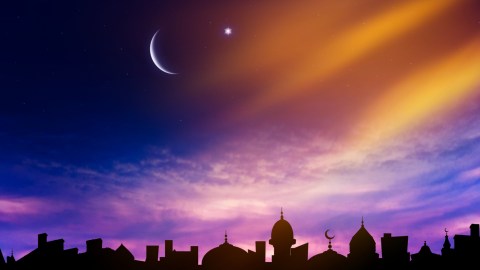Ramadan and science

Muslims around the world recently completed Ramadan, “the month of fasting.” Fasting (in Islam, from food, drinks, and sexual intercourse) is both an act of worship (a devotion to God) and a physical conditioning for higher psychological and spiritual states of mind, to connect more strongly with God and act more in altruistic and forgiving ways.
But while Ramadan is a month of spiritual and social uplifting, one finds important connections to science, most particularly astronomy and medicine.
First, Ramadan’s connection to astronomy is through the (Islamic) lunar calendar, of which Ramadan is the ninth month. Astronomically, the lunar month begins when the moon crosses the Earth-Sun direction (a position and moment known as “conjunction,” or more commonly “new moon”), but Islamically the month begins when the moon can be seen as a thin crescent, a day or so after the new moon. And since lunar months are either 29 or 30 days long, Muslims have traditionally gone out on the evening of the 29th of Shaaban (the month preceding Ramadan) to try to sight the crescent and thus start the holy month.
This definition and procedure for determining the start and end of Ramadan leads to interesting complications. This approach, advocated by Prophet Muhammad for its simplicity (Arabs then had little scientific knowledge), soon proved to have its limitations and drawbacks. First and foremost, this approach does not allow one to plan ahead, as one must wait for the 29th day to know whether the next day will be the 30th of that month or the 1st of the next. But calendars are needed for any society to organize its affairs, including work schedules, which changes in Ramadan, meal times, holidays (at the end of the month), travels, etc. And indeed, the Islamic civilization soon developed calendars, at least for civil purposes, for example the “arithmetic calendar,” alternating 29 and 30 days with a complex rule to determine whether the year will be a regular or a leap year, totaling 354 or 355 days.
Another issue that soon appeared was whether different regions should start a month together, or to each its own crescent sightings and thus different Ramadan starts and ends. Indeed, in the old days, if a crescent was seen in Mecca, people in Medina could not be promptly informed about it, but it surely didn’t make sense for nearby lands to have different months and religious occasions, especially when Hajj/Pilgrimage (which takes place in Mecca on the 10th day of the last month of the year) is common for everyone.
And thirdly, once scientific calculations and technologies (telescopes, cameras, etc.) became available and even common among Muslims, the question became: should the old traditional method, which was good for its time, be replaced by scientific calculations, observations, and calendrical systems?
An ancient problem
Astronomical determining when a crescent could be seen is an old problem that goes back to the Babylonians, who had figured a simple rule: the new crescent will be seen if the moon sets at least 48 minutes (12 degrees) after the sun. And since astronomers could calculate the positions and motions of the moon and the sun quite well, they could predict the “lag time” between them and hence whether the crescent would be seen.
The problem was also taken up by Muslim astronomers, including the illustrious Al-Khwarizmi (9th century), Ibn Yunus (11th c.), and Al-Tusi (13th c.), and they came up with similar but more accurate prediction criteria: 9 to 11 degrees between the sun and the moon.
During the 20th century, more sophisticated approaches were developed, with seminal contributions by Western astronomers, particularly André-Louis Danjon, Franz Bruin, and Bradley Schaefer, and Muslim astronomers, e.g. Muhammad Ilyas, with the introduction of astrophysical considerations such as the contrast of brightness between the moon and the background sky at the crucial moment of observation.
All this has helped cut down on the high rate of mistakes made by people who try to sight the crescent. Indeed, studies have shown that during the second half of the 20th centuries, error rates in the Arab world ranged between 50 and 90 percent! New thin crescents are indeed notoriously difficult to see, especially in places with lots of sand dust, pollution, or humidity. Science then helped sort out erroneous reports from correct ones.
But the fundamental issue remained: should we carry on with the sighting procedure (with or without instruments), or should we use calculations to construct a calendar and do away with the old sighting method? A majority of Muslim jurists still insist on the old tradition, but there has (slowly) been growing awareness of the importance of constructing and adopting a calendar, for both civil and religious purposes.
Health benefits . . . and risks
Ramadan also relates to medicine, as fasting can have great health benefits, but can also have detrimental effects, at least in some situations. Indeed, fasting has been practiced for millennia, by many cultures in various forms (alternate-day fasting, dietary restrictions, etc.), for religious and/or health reasons.
Recent studies have shown benefits of different types of fasting (e.g. “mini-fasts”): the 5-2 diet (no more than 500 calories during 2 days of the week); caloric restriction during 5 days (1000 calories on Day 1, then 700 for the next 4 days); eating only during 8-12 hours for 5 days of the week, etc.
And in addition to a number of benefits found in animals (mice), the following positive effects have been found in humans: up to 30 percent decrease in cholesterol; 20 percent improvement in diabetes; decrease in blood pressure and triglycerides, increase in red blood cells and platelets; and possible other benefits (improvements in blood lipids and glucose, etc.).
But fasting can be harmful in some cases; indeed, studies have shown dangers (the “Ramadan syndrome”) when the fasting period is very long (16 hours or more): peptic ulcers, pancreatitis and gastric dilatation; etc. And indeed, Ramadan, which shifts by 11 days each year due to the difference between the lunar and the solar year, nowadays falls in May when days are very long in northern regions (Scandinavia, Scotland, etc.). Fasting for long days over a whole month can be harmful for some people.
I should note that the Qur’an gives permission to “ill” people not to fast (and if possible make up those days at later times); however, the definition of “ill” is somewhat fuzzy, and most people, even those with chronic diseases (e.g. diabetes) insist on fasting, recalling that the Qur’an states “And it is better for you to fast” (when you can).
Other negative effects relate to the lack of water and to the reduction in sleep hours: decrease in concentration and cognitive functions (important for students in particular); general physical fatigue (affecting drivers and heavy machine operators); irritability and bad moods; etc.
I wanted to show the strong connections between Ramadan and some fields of science, and how the latter can shed some helpful light on issues surrounding this ancient tradition. This can be a perfect example of complementarity between religion (spiritual and social uplifting) and science (correct handling of various worldly matters).
The post Ramadan and Science appeared first on ORBITER.





